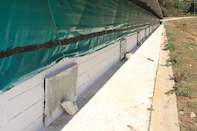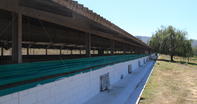
Temperatures
Recommended housing temperatures for chicken will differ from one breed to another, with certain breeds, such as naked necks, being able to withstand warmer temperatures than other breeds.
Naked neck chicks on the other hand are more vulnerable to cold climatic conditions, so it makes sense to produce a breed that is suited for the climatic conditions in your production environment especially if the birds will be kept outside.
The ideal temperatures to keep birds will depend on humidity levels. Commercial layers however should ideally be kept at temperatures ranging from 20°C to 24°C. Birds consume more food in an attempt to stay warm with every 1°C below this range, while egg quality, production and consumption being negatively affected when temperatures rise above this range.
Recommended housing temperatures for commercial broilers are highly age dependent. As a general rule day-old chicks need a temperature of 34°C to thrive, thereafter temperatures can be reduced by 0,3°C each day until temperatures reach 20°C in the fourth week.
Not only should thermometers be placed about a knee high from the ground to measure and monitor temperatures at various spots in the poultry house, but farmers should also watch their chicken to see if they are comfortable.
Birds that are cold will huddle together in one place to keep warm, whereas those that are warm will spread out and away from heat sources. Chicken that are too hot will also pant and gasp for air.
When it is Cold
Various forms of heating can be used to increase temperatures, from electric to gas, solar and wood gas burning. These system may also be automatic or manual. Consider the cost and availability of resources when deciding on the system to use.
If the production region gets very cold, it might be a good idea to rather farm with point of lay hens that are older and therefore better able to withstand cool temperatures than day-old broiler chicks, or to plan production to avoids having birds on the property during these times.
If open buildings are used, windows can be closed with curtains to keep the building warm.
Ventilation should be used to evenly disperse heat throughout the house. Poor heat distribution can result in some birds growing faster than others and in effect poor bird uniformity.
The production area can be reduced by halving the production area with a curtain when the birds are small.
Buildings should be insulated and sealed to prevent cold draughts.
Heat Stress Affects the Bird’s Metabolic Processes

Farmer’s Weekly has the following tips to address heat stress in birds:
Ventilation should be increased to move hot air away from the chicks. This can be done by opening curtains in open houses or by using fan-assisted ventilation.
If the birds are free range, they should have access to shade.
Birds should have access to enough cool water. They will not drink the water if it is warm.
Feed can be removed during peak hot periods and supplied during cooler times.
Pellets and crumbles should be given to birds instead of dusty mash to reduce energy wasting.
Feed should be supplemented with minerals and vitamins to replace losses caused by dehydration and panting.
Handling of the birds should also be limited during the middle of the day when temperatures are at their highest.
Stocking densities can be reduced.